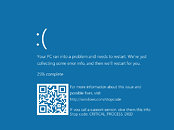- Joined
- Oct 9, 2007
- Messages
- 47,849 (7.39/day)
- Location
- Dublin, Ireland
| System Name | RBMK-1000 |
|---|---|
| Processor | AMD Ryzen 7 5700G |
| Motherboard | Gigabyte B550 AORUS Elite V2 |
| Cooling | DeepCool Gammax L240 V2 |
| Memory | 2x 16GB DDR4-3200 |
| Video Card(s) | Galax RTX 4070 Ti EX |
| Storage | Samsung 990 1TB |
| Display(s) | BenQ 1440p 60 Hz 27-inch |
| Case | Corsair Carbide 100R |
| Audio Device(s) | ASUS SupremeFX S1220A |
| Power Supply | Cooler Master MWE Gold 650W |
| Mouse | ASUS ROG Strix Impact |
| Keyboard | Gamdias Hermes E2 |
| Software | Windows 11 Pro |
With its latest Preview Build (build 14316), Microsoft patched Windows 10 to make BSOD (blue-screen of death) errors more useful for system analysts and power-users. The blue-screen now puts up a QR-code to the knowledge-base page related to the error. Microsoft also set up an easy to remember URL at "windows.com/stopcode" for quick-reference to info and possible fixes to various kinds of errors.
The Register makes a valid case for how QR-codes in BSOD screens can be misused by malware developers. Malware or ransomware developers can now make their wares fake a BSOD screen with a QR-code that leads to their web-page to steal your information, or point you to download even more malware.

View at TechPowerUp Main Site
The Register makes a valid case for how QR-codes in BSOD screens can be misused by malware developers. Malware or ransomware developers can now make their wares fake a BSOD screen with a QR-code that leads to their web-page to steal your information, or point you to download even more malware.

View at TechPowerUp Main Site



